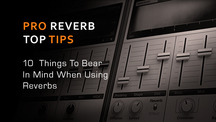Looking to add some sheen to your track? Here are some nice reverb tips to keep your productions sounding lush:
1. A Different Take on Reverse Reverb
You all know the classic reverse reverb, where the reverse seems to swoosh in before the phrase of the singer or the hit of the drum. A neat trick for something different is to record an infinite reverb on a different track and then reverse it. For example, say you have a slow intermission type middle part and the part before ends on a snare hit. You can record that last snare hit on a different track with a big cathedral like reverb with infinite decay. Then you can reverse the audio part and put it low in the mix, then you have a weird controlled reverbed ambience filling out your slow part.
2. Gated Reverb on vocals
Gated-reverb on vocals is something I think is pretty cool. I think this is used on the song On call, by Kings of Leon. His vocal reverb stays on while singing but cuts off abruptly when he stops. You patch your effect processor to a gate and the sound source is side-chained to the gate. That way, the gate opens and lets the reverb out whenever the singer is singing, but cuts off as soon as the sound level dips below the threshold of the gate.
3. Making things feel bigger and bigger
Say you have a really spaced out Sigur Ros rock outro(I’m Icelandic, I’ve got to namedrop here) and the drums are going wild in the end. It can be fun experimenting with automating the reverb so the drums, or maybe only the snare, or everything, whatever you choose, gets bigger and bigger. I know for a fact that this can work wonders live to really give that last song a huge impact on the audience.
4. Pan it
Use mono reverb for a mono sound source and pan them to a different location in the mix. It can give an interesting impression.
5. Put space between source and reverb
Using a standard room reverb, adjust the pre-delay to give the impression it is a little bit bigger without making it linger too long. On vocals for example, it can give space between the singing and the reverb.
6. Pre Fader
Try using reverb as a pre-fader effect and automate the track's volume fader down for an interesting effect. It will seem as if your original sound is "walking into the distance" leaving only the reverberated sound. Find out more about how to do this here.
7. Reverb only
Send your drums to a big reverb and solo-safe the reverb. That way you are only hearing the reverb and not the original sound source. It can make for a cool fade-in intro for a song. Especially if you add reverse reverb for the change into the real drum kit.
8. Mix it up
Use different types of reverb on the same source. Mixing a couple of types of reverb can create an interesting effect.
9. Or Don’t Use Any!
Keep some instruments reverb-free. It can add an interesting contrast to the rest of the song. It can put a solo intrument to the forefront in a special way.
10. Add other effects:
Add other types of effects on the aux channel where you have your reverb. Try distorting it, phasing it or anything else you can think of.












